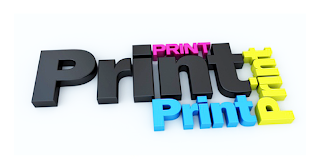Method of printing
The most common and commercially used method of printing is
screen printing and roller printing. Heat-transfer printing is a third lesser
used method. Other types of printing, such as block, batik, and ikat printing,
are rarely used in commercial production of textile around the world and are
often used only as craft.
Screen Printing
Screen- Printing involves the usage of a printing screen
made from fine mesh screen made from nylon, polyster, or metal tightly mounted
on a wooden or metal frame. The printing process is done by placing the screen
on top of the fabric which is to be printed. Print paste is poured onto the
frame and squeezed through the mesh area by a squeegee. Each color in a print
design requires its own screen and a separate process. The process can be made
by hand or automated machine.
Hand screen printing
In hand screen – printing, the designed of printing in
screen is attached on wooden framed. Fabric is placed on the table, the frame
put above fabric accordingly. The paste of pigment dye is poured into the
screen. By hand (manual), the paste is wiped right direction and vice versa. Then
the frame is took up, the printed fabric is moved for drying. The rate of
production ranges from 50 to 90 yards per hour.
Machine screen printing
Automatic flat bed screen –printing is much faster in term
of production output, about 500 yards per hour. The fastest screen printing
method is rotary screen printing, in which 3500 yards of printed fabric can be
produced in a hour. Fabric is fed into the machine, which passes through a set
of rotary screen cylinders. Instead of a flat screen, perforated metal or
plastic screens in a cylinder form screen are used.
Roller printing
Roller printing is high speed printing process, capable of
producing 6000 yards of printed fabric per hour. In this method, the design is
engraved onto copper rollers, a separate roller for each color. Very fine and
delicate designs can be produced through roller printing. It is only economical
to use this method for production of large quantitaties.
Heat- transfer printing
Heat transfer printing (also called thermal transfer
printing), the design is first printed on the paper with printing ink
containing dyes of the disperse dye class. The transfer paper is then place
face to face with the fabric and heated at high temperature in the machine. The
printed designs on the paper will then transfer onto the fabric surface. The rate
of production is about 250 yards per hour.
Type of prints
Direct Print
Direct print: in this type of printing, the design is
printed directly onto a white fabric. If the design is printed on a pre-dyed
fabric, it is then called an overprint.
Discharge Print
Discharge Print: a two step process in which the first step
is to piece dye the fabric and the second step is to print over the dyed fabric
with a bleaching agent.
Resist print
Resist print: also a two step process in which the design is
first printed onto a white fabric with chemical or wax like substance and later
piece dye. The chemical will resist the dyeing of the fabric. The most common
type of resist printing is batik
Pigment Print
Pigment Print: similar to direct print terms of procedure,
however, instead of using dyestuffs (wet printing), pigment are used. Thus,
pigment print is also called dry printing. Prints using pigment tend to be
stiffer but have excellent fastness to light
Blotch print
Blotch print: in blotch printing, the background color is
printed, along with the pattern, instead of piece dyeing.
Flock Print
Flock Print: similar to flock printing, this type of print
is achieved by using fiber flock applied on a fabric with adhesive. Instead of
using dyestuff or pigments as a medium, adhesive is used to create the design. The
fiber flock will only stick to the area where the adhesive was previously
applied.
Burn Out Print
Burn out Print: this involves printing with a chemical
substance that destroys the fiber in the patten area. Thus holes will result
where the chemical was applied






